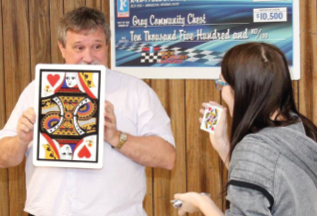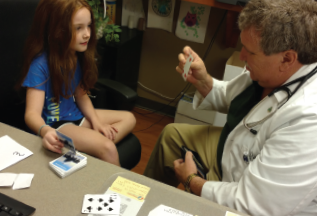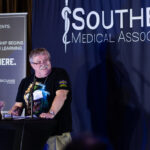
Dr. Morris displays the card that his daughter, Amanda, randomly chose.
Ever wonder how magicians know what card you pulled out of the deck, make objects vanish or unlink and link solid metal rings?
Christopher Morris, MD, knows how these tricks are performed, but he won’t tell you. A rheumatologist who has been in private practice for 25 years at Arthritis Associates, Kingsport, Tenn., he has also been a card-carrying member of the International Brotherhood of Magicians (IBM) for more than 40 years, obtaining the Order of Merlin rank.
Dr. Morris says rheumatologists and magicians are a lot alike in that they’re both sleuths who solve puzzles. Although he doesn’t pull rabbits out of hats, he can perform at least 100 different magic effects that will keep you watching and wondering, “How the heck did he do that?” His magic acts have amazed students in middle school, college fraternity brothers and rheumatologists at meetings.
Secret Society
Dr. Morris says his passion for magic began when his grandfather gave him his first magic set for his 8th birthday. His parents made it a tradition to buy him magic tricks throughout his childhood. In middle school, he entertained children at birthday parties and performed a few magic acts in his school play, but he rarely performed before large crowds. He says learning magic is time consuming, and he mostly reserves performances for family and friends.
Rheumatologists & magicians are a lot alike in that they’re both sleuths who solve puzzles.
While attending medical school at Universidad Autónoma de Guadalajara, Mexico, he didn’t have much time to practice his magic. After graduating in 1987, he moved on to a rotating internship at the University of California, Irvine, School of Medicine, and completed his internal medicine residency in 1991 at the University of Tennessee Graduate School of Medicine, Knoxville. He completed the first year of his fellowship in 1992 at Wake Forest University School of Medicine in Winston-Salem, N.C., and the second year at the Medical College of Georgia, Augusta. He joined his father’s rheumatology practice in 1993.
“There are very few specialties where you get to be a sleuth with your patients and try to solve puzzles,” he says. “Rheumatologists see strange and unusual diseases. But when you come up with a diagnosis that no one could figure out, that’s what makes it sort of fun. It makes you feel great.” Dr. Morris experiences similar feelings with magic.
During his undergraduate years at Tulane University in New Orleans, Dr. Morris helped arrange for Harry Blackstone Jr., a stage magician known for pulling at least 80,000 rabbits from his sleeves and hats, to perform at the university. By then, Dr. Morris was a bona fide magician and was allowed to watch the act from backstage.
Mr. Blackstone “was amazing to watch and learn from,” he says. “But I will never tell a soul how his tricks were done.”
Magic, Medicine & Bridge

Dr. Morris performs a card trick with Ava Marie Brown, the daughter of colleague and rheumatologist Annette Abril, MD.
vchal / shutterstock.com
Dr. Morris’ favorite types of magic involve card tricks, as well as the cut-and-restored rope trick, in which a rope is cut in two pieces, tied in a knot and then—abracadabra—perfectly restored.
He demonstrates his magic in front of other magicians at local IBM clubs, where fellow magicians test, learn and share new tricks. But Dr. Morris applies magic in other areas as well. A former Sunday School teacher, Dr. Morris found a clever way to incorporate magic into his lessons.
“When getting ready to teach kids reconciliation, which is when they go into confession, I would take black handkerchiefs that signified their sins and put them in a bag,” he says. “Then I’d say, ‘After confession, when you’re forgiven by God, here’s what happens.’ I’d pull out a white handkerchief and show them the black ones were gone.”
Magic has other purposes, too. It’s great for breaking the ice between people at ACR meetings, he says, or during uncomfortable or difficult situations.
Meanwhile, Dr. Morris practices tricks several times a month to avoid sleight of hand mistakes. He also spends several hours each night the week before IBM meetings practicing tricks he plans on sharing.
Dr. Morris believes there’s a clear relationship between medicine and magic, and he says his third hobby has a strong connection to both. He plays contract bridge, a card game he learned as a child while on family vacations.
“Every hand is a different puzzle,” he says. His wife, Jane, has been his bridge partner for decades, and they play in roughly a dozen tournaments each year. “For 25 years, I’ve also been the prize desk chairman at the Gatlinburg Regional Bridge Tournament, handing out small event prizes, such as a $2 bill or flashlight, to players.”
He says one common factor between bridge, medicine and magic is observation—a skill necessary to correctly diagnose patients, figure out how a trick is performed and know what cards to play at what time.
Advice to Colleagues
“You need to have a fun, outside activity with normal, everyday people who think TNF is a new internet abbreviation,” Dr. Morris says. “Magic is fun and makes everybody feel like a kid again.”
Carol Patton is a freelance writer based in Las Vegas.



